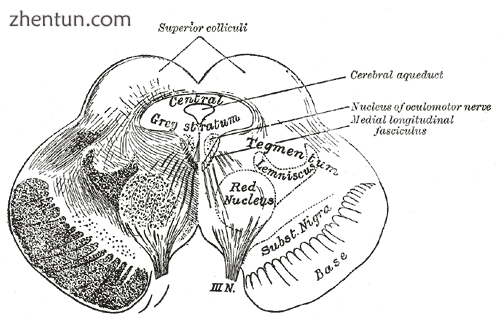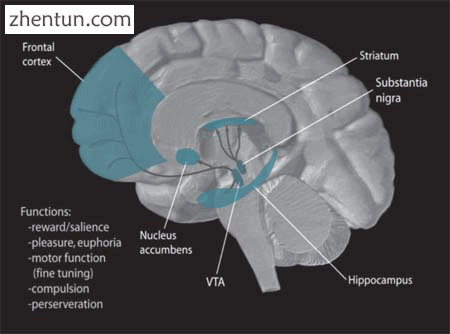腹侧被盖区(VTA)(被盖是拉丁语用于覆盖),也称为Tsai腹侧被盖区[1]或简称腹侧被盖,是一组位于中脑底部中线附近的神经元。 VTA是中脑皮质边缘多巴胺系统和其他多巴胺途径的多巴胺能细胞体的起源; 它广泛涉及大脑的药物和自然奖励回路。 VTA在许多过程中发挥着重要作用,包括认知,动机,性高潮,[2]和与爱有关的强烈情绪,以及一些精神疾病。 VTA中的神经元投射到大脑的许多区域,从前额叶皮层到尾侧脑干以及其间的几个区域。
https://cache.tv.qq.com/qqplayerout.swf?vid=g0864zjnnlj
视频:2分钟神经科学 - 腹侧被盖区(VTA)

中脑横断面上丘的水平。 (被盖在中间右侧。)
目录
1 结构
1.1 位置
1.2 细分
1.3 输入
1.4 产出
1.5 发育
2 功能
2.1 存在间隙连接
2.2 神经组成
2.3 边缘循环
2.4 CA3循环
2.5 奖励制度
3 临床意义
3.1 障碍
3.2 吸毒成瘾
4 比较解剖和进化
5 参考文献
结构

VTA在人体中的解剖位置
神经生物学家经常很难区分人类和其他灵长类大脑的VTA与黑质(SN)和周围的细胞核。最初,腹侧被盖区被指定为“核”,但随着时间的推移,“区域”成为更合适的术语,因为该区域具有异构的细胞构造特征,缺乏将其与邻近区域分开的明显边界。由于VTA的选择性边缘相关传入,VTA的细胞被命名为A10,以区别于周围细胞。
区域
腹侧被盖区域位于几个其他主要区域之间的中脑区域,其中一些区域在此处描述。包括在间脑中的乳头体和后下丘脑从VTA向外延伸。红色核位于侧面,动眼神经纤维位于VTA的腹内侧。脑桥和后脑位于VTA的尾部。最后,黑质位于VTA的横向。
细分
1987年,Oades在VTA A10细胞群中鉴定出四个原代细胞核:颅内核(Npn),腭裂核(Npbp),细胞核(Nif)和线状核(Nln)尾静脉和延髓炎。目前,科学家将VTA分为四个相似的区域,称为颅内核(PN),臂旁色素区(PBP),旁筋膜反射区(PFR),以及大体上的内侧肌细胞核(RMTg)。以前的部门。 VTA的一些定义还包括中线核(即,束间核,嘴侧线性核和中央线性核)。
PN和PBP富含多巴胺能细胞,而另外两个区域具有这些神经元的低密度。 PFR和RMTg含有低密度的酪氨酸羟化酶(TH)阳性细胞体,体积小,染色轻; RMTg主要由GABA能细胞组成。另一方面,PN和PBP主要由适度染色的中到大型TH阳性细胞体组成。
输入
几乎所有从VTA项目中获得预测的区域都会回归它。因此,腹侧被盖区与整个大脑中的各种结构相互连接,这表明它在系统发育上较新且高度发育的新皮质以及系统发育上较老的边缘区域的功能控制中起作用。
VTA不是同源区域,因为它由多种神经元组成,其特征在于不同的神经化学和神经生理学特性。因此,谷氨酸能和GABA能的输入不仅仅是抑制性的,也不仅仅是兴奋性的。 VTA接受来自前额叶皮质,足弓根管核(PPTg),晚期背侧肌核,丘脑底核,纹状体末端的床核,上丘,以及下丘脑外侧和视前区的谷氨酸能传入[3]。
VTA的GABA能输入包括伏隔核,腹侧苍白球和内窥镜中央核(RMTg)。外侧缰核通过激发RMTg GABA能神经元对VTA中的多巴胺能神经元发挥抑制作用,这被认为在奖赏预测误差中起重要作用。[4]
投射入VTA的大多数结构都会产生兴奋性谷氨酸过敏。这些谷氨酸能传入物在调节VTA细胞发射中起关键作用。当谷氨酸能神经元被激活时,多巴胺神经元的放电率在VTA中增加并诱导爆发放电。研究表明,VTA中的这些谷氨酸能作用对滥用药物的作用至关重要。相比之下,腹侧被盖区的尾部(tVTA,也就是RMTg)与GABAergic传入神经向VTA投射,作为VTA多巴胺通路的“主制动器”。[5] [6]
进入VTA的亚慢性传入神经主要是GABA能,因此具有抑制作用。从亚苍白球区到VTA有一条很大的途径。当这条途径被去抑制时,中脑边缘的多巴胺释放增加途径放大运动活动。
输出
VTA的两个主要传出纤维投影是中皮质和中脑边缘通路,分别对应于前额皮质和伏隔核[7] [8]。下面列出了所有使用多巴胺作为其主要神经递质的全套预测。[7]
腹侧被盖区(VTA)预测[7]
VTA→杏仁核
VTA→扣带回
VTA→海马
VTA→伏隔核
VTA→嗅球
VTA→前额皮质
发育
因为它们从共同的胚胎组织发育并且在它们的投射区域中部分重叠,所以多巴胺能细胞群缺乏清晰的解剖学边界。在哺乳动物大脑发育期间,黑质(SN)和VTA神经元最初都投射到背外侧和腹内侧纹状体。然而,在出生时,SN多巴胺能神经元专门投射到背外侧纹状体中,并且VTA多巴胺能神经元仅投射到腹内侧纹状体中。这种关系的修剪是通过消除不必要的抵押品来实现的。
功能
如上所述,VTA,特别是VTA多巴胺神经元,在奖励系统,动机,认知和药物成瘾中起几种作用,并且可能是几种精神疾病的焦点。它也被证明可以处理来自杏仁核的各种类型的情绪输出,它也可以在避免和恐惧条件方面发挥作用。电生理记录已经证明VTA神经元对新刺激,意外奖励和奖励预测感觉线索有反应。这些细胞的发射模式与奖励预期误差的编码一致。
2006年,Helen Fisher和她的研究小组进行的MRI研究发现并记录了与强烈的爱情相关的各种情绪状态与VTA中的活动相关,这可能有助于解释被拒绝的伴侣的强迫行为,因为这是由奖励系统共享的。巢分享行为与新配对斑胸草雀的VTA中V1aR表达增加有关。[9]然而,V1aR表达与女性定向歌曲率无关,这可能表明血管紧张素在VTA中对配对维持与求偶行为的选择性作用。[9]
存在间隙连接
已经证明VTA具有通过间隙连接相互连接的大型GABA能神经元网络。该网络允许电传导,这比突触之间信号的化学传导快得多。[10]
神经组成
与黑质一样,VTA中含有黑色素色素沉着的多巴胺能神经元。[11]最近的研究表明,多巴胺能神经元占VTA中所有神经元的50-60%,[12]这与先前的证据相反,后者认为VTA中77%的神经元是多巴胺能的。[13]此外,在脊柱内侧肌细胞核(RMTg)中存在相当大量的GABA能神经元,这是一种功能上不同的脑结构。[5] [6]这些GABA能神经元调节其多巴胺能对应物的发射,其将整个脑中的投射传递到(但不限于)以下区域:前额皮质,伏隔核和蓝斑。 VTA还含有一小部分兴奋性谷氨酸能神经元。
边缘循环
“边缘环”非常类似于基底神经节的直接通路运动环。在这两个系统中,从皮层到纹状体(伏隔核)有主要的兴奋性输入,中脑将神经调节的多巴胺神经元投射到纹状体,纹状体与苍白球形成核间连接,而苍白球则有输出到丘脑,到皮质,从而完成循环。边缘环与运动环的区别在于皮质输入的来源和性质,处理输入的纹状体和苍白球的分裂,来自中脑的多巴胺能神经元的来源,以及苍白球输出的丘脑目标。
CA3循环
将背景与奖励联系起来对于奖励寻求非常重要。 2011年,一组研究人员记录了使用侧隔膜作为中介的VTA-CA3环。他们使用伪狂犬病病毒(PRV)作为跨突触示踪剂,并将其注射到VTA中。他们发现单侧注射VTA导致注射后48小时开始在CA3中进行双侧PRV标记。在VTA PRV注射之前的尾侧间隔(cd-LS)的损伤导致CA3中PRV标记的神经元显着减少。 θ3的θ波刺激导致VTA中多巴胺细胞的放电率增加,并且VTA中GABA神经元的放电率降低。通过记录神经元的neurobiotin TM标记确认VTA神经元的身份,然后对酪氨酸羟化酶(TH)进行组织学染色。通过GABA激动剂暂时灭活CA3可以防止背景诱导的静脉注射可卡因的压力恢复。[14]
作者提出了一个功能性回路循环,其中CA3中谷氨酸能细胞的激活引起cd-LS中GABA能细胞的活化,其抑制VTA中的GABA中间神经元,释放多巴胺细胞免受强直抑制,并导致增加的激发率。多巴胺细胞。[14]
奖励系统
人脑中的多巴胺奖励回路涉及从腹侧中脑到伏隔核 - 嗅结节复合体的两个投射系统。首先,后内侧VTA和中央线性中缝细胞选择性地投射到腹内侧纹状体,其包括内侧嗅结节和内侧NAC壳。其次,侧向VTA主要向腹外侧纹状体突出,其包括NAC核心,内侧NAC壳和侧嗅结节。这些途径分别称为meso-ventromedial和meso-ventrolateral纹状体多巴胺系统。内侧投影系统在以情感和驱动为特征的觉醒调节中是重要的,并且在侧向投影系统中在目标导向行为中起不同的作用。与侧面部分不同,内侧部分不是通过奖励而是通过有害刺激来激活。[15] [16]因此,NAC外壳和后VTA是奖励系统中涉及的主要区域。
临床意义
疾病
黑质的多巴胺能神经元和中脑的腹侧被盖区域分别突出到背外侧尾状核/壳核和腹内侧伏隔核,建立中间纹状体和中脑边缘通路。这两条通路的紧密接近使它们在多巴胺能投射下聚集在一起。这两种途径的破坏导致了几种疾病:精神分裂症,帕金森病和注意力缺陷多动障碍(ADHD)。目前的研究正在研究这些病症中涉及的神经元之间的微妙差异,并试图找到一种选择性治疗特定多巴胺投射的方法。
吸毒成瘾
主要部分:成瘾§奖励制度
伏隔核和腹侧被盖区是成瘾药物起作用的主要部位。以下通常被认为是令人上瘾的:海洛因,可卡因,酒精,阿片类药物,尼古丁,大麻素,安非他明及其类似物。这些药物通过延长伏隔核中多巴胺的作用或通过刺激那里和VTA中神经元的激活来改变多巴胺对增强信号处理的神经调节作用。最常见的滥用药物会刺激多巴胺的释放,从而产生有益效果和精神运动效应。强制性吸毒行为是由重复多巴胺刺激引起的中脑边缘多巴胺系统的永久性功能变化的结果。分子和细胞适应是造成VTA中的敏感多巴胺活性以及响应药物滥用的中脑边缘多巴胺预测的原因。在成瘾个体的VTA中,多巴胺合成酶酪氨酸羟化酶的活性增加,这些神经元对兴奋性输入的反应能力也增加。后一种作用继发于转录因子CREB活性的增加和GluR1的上调,GluR1是谷氨酸的AMPA受体的重要亚基。神经处理的这些改变可以解释适应性情绪信号在决策能力运作中的影响逐渐减弱,因为寻求药物和吸毒行为变得习惯性和强迫性。
在大鼠中进行的实验表明,他们学会按压杠杆,将刺激性药物施用于后VTA,而不是前VTA。其他研究表明,多巴胺能药物微量注射到伏隔核壳中会增加运动活动和探索行为,条件性接近反应和预期性行为。
退出现象的发生是因为奖励功能的不足引发了一种窘迫循环,其中药物成为恢复正常稳态的必要条件。最近的研究表明,即使在戒断的最后阶段过去之后,如果暴露于药物或与药物相关的刺激,也可以恢复寻求毒品的行为。
比较解剖和进化
自1964年以来的所有研究都强调了从啮齿动物到人类的所有哺乳动物的VTA之间令人印象深刻的一般相似性。这些研究的重点是大鼠,兔子,狗,猫,负鼠,非人类灵长类动物和人类。注意到存在轻微差异,例如A10细胞背侧范围的变化。具体而言,与其他哺乳动物相比,A10细胞的背峰在灵长类动物中更为广泛。此外,VTA中多巴胺能细胞的数量随着系统发育进展而增加;例如,小鼠的VTA包含大约25,000个神经元,而33岁男性的VTA包含大约450,000个细胞体[17]
另见
Phenylalanine
List of regions in the human brain
参考
Phillipson, O. T. (1979). "Afferent projections to the ventral tegmental area of Tsai and interfascicular nucleus: A horseradish peroxidase study in the rat". The Journal of Comparative Neurology. 187 (1): 117–143. doi:10.1002/cne.901870108. PMID 489776.
Holstege, G.; Georgiadis, J. R.; Paans, A. M.; Meiners, L. C.; Van Der Graaf, F. H.; Reinders, A. A. (2003). "Brain activation during human male ejaculation". The Journal of Neuroscience. 23 (27): 9185–9193. PMID 14534252.
Morikawa, H; Paladini, CA (15 December 2011). "Dynamic regulation of midbrain dopamine neuron activity: intrinsic, synaptic, and plasticity mechanisms". Neuroscience. 198: 95–111. doi:10.1016/j.neuroscience.2011.08.023. PMC 3221882. PMID 21872647.
Watabe-Uchida, Mitsuko; Eshel, Neir; Uchida, Naoshige (July 2017). "Neural Circuitry of Reward Prediction Error". Annual Review of Neuroscience. 40: 373–394. doi:10.1146/annurev-neuro-072116-031109. PMID 28441114.
Bourdy R, Barrot M (November 2012). "A new control center for dopaminergic systems: pulling the VTA by the tail". Trends Neurosci. 35 (11): 681–690. doi:10.1016/j.tins.2012.06.007. PMID 22824232. In light of the crucial role of the tVTA in the opiate control of dopamine activity ...
In the context of addiction, the tVTA is a target for psychostimulant-induced plasticity [1,6,23] and is also essential for morphine action on dopamine neurons [19]. This latter finding suggests that the classical disinhibition model may need to be revisited in light of the GABAergic control that the tVTA exerts on dopamine systems. ...
The tVTA is rich in inhibitory GABA neurons expressing μ-opioid receptors and sends extensive projections toward midbrain dopamine cells. It is proposed as a major brake for dopamine systems. ...
The tVTA was initially described in rats as a bilateral cluster of GABA neurons within the posterior VTA, dorsolateral to the interpeduncular nucleus, and expressing FosB/ΔFosB after psychostimulant administration [1]. However, the Fos staining showed that this group of cells extends caudally beyond the defined borders of the VTA [1], shifting dorsally to become embedded within the superior cerebellar peduncle [2]. Around the same time as the tVTA was described, a region caudal to the rat VTA and lateral to the median raphe was proposed to influence passive aversive responses [24]. This region belongs to the reticular formation and was later designated as RMTg [3]. The RMTg extends rostrally, shifting ventrally to become embedded within the posterior VTA. A similar region has also been observed in primates [18] and in mice [25]. There is now agreement that the tVTA and RMTg are two faces of the same structure.
Barrot M, Sesack SR, Georges F, Pistis M, Hong S, Jhou TC (October 2012). "Braking dopamine systems: a new GABA master structure for mesolimbic and nigrostriatal functions". J. Neurosci. 32 (41): 14094–14101. doi:10.1523/JNEUROSCI.3370-12.2012. PMC 3513755. PMID 23055478. The tVTA/RMTg sends dense GABA projections to VTA and substantia nigra neurons. ...
Indeed, tVTA/RMTg cells express high levels of mu-opioid receptors (Jhou et al., 2009a, 2012; Jalabert et al., 2011), and in vivo, ex vivo and optogenetic electrophysiological approaches demonstrated that morphine excites dopamine neurons by targeting receptors localized to tVTA/RMTg cell bodies as well as its terminals within the VTA (Jalabert et al., 2011; Lecca et al., 2011; Matsui and Williams, 2011; Lecca et al., 2012). ... Recent research on the tVTA/RMTg started from observations related to psychostimulant induction of FosB/ΔFosB (Perrotti et al., 2005) and to the control of aversive responses (Jhou, 2005). The rat tVTA/RMTg showed a neuroanatomically delimited increase in the expression of Fos-related proteins following exposure to psychostimulants (Scammel et al., 2000; Perrotti et al., 2005; Geisler et al., 2008; Jhou et al., 2009a; Kaufling et al., 2009, 2010a, 2010b; Rottlant et al., 2010; Zahm et al., 2010; Cornish et al., 2012). This induction was observed with both acute and chronic exposure to psychostimulants, and with both self-administration and non-contingent administration. There is a strong selectivity of this molecular response, as the Fos-related induction was never observed with non-psychostimulant drugs (Perrotti et al., 2005; Kaufling et al., 2010b).
Malenka RC, Nestler EJ, Hyman SE (2009). "Chapter 6: Widely Projecting Systems: Monoamines, Acetylcholine, and Orexin". In Sydor A, Brown RY (eds.). Molecular Neuropharmacology: A Foundation for Clinical Neuroscience (2nd ed.). New York: McGraw-Hill Medical. pp. 147–148, 154–157. ISBN 9780071481274. Neurons from the SNc densely innervate the dorsal striatum where they play a critical role in the learning and execution of motor programs. Neurons from the VTA innervate the ventral striatum (nucleus accumbens), olfactory bulb, amygdala, hippocampus, orbital and medial prefrontal cortex, and cingulate cortex. VTA DA neurons play a critical role in motivation, reward-related behavior, attention, and multiple forms of memory. ... Thus, acting in diverse terminal fields, dopamine confers motivational salience ("wanting") on the reward itself or associated cues (nucleus accumbens shell region), updates the value placed on different goals in light of this new experience (orbital prefrontal cortex), helps consolidate multiple forms of memory (amygdala and hippocampus), and encodes new motor programs that will facilitate obtaining this reward in the future (nucleus accumbens core region and dorsal striatum). ... DA has multiple actions in the prefrontal cortex. It promotes the "cognitive control" of behavior: the selection and successful monitoring of behavior to facilitate attainment of chosen goals. Aspects of cognitive control in which DA plays a role include working memory, the ability to hold information "on line" in order to guide actions, suppression of prepotent behaviors that compete with goal-directed actions, and control of attention and thus the ability to overcome distractions. ... Noradrenergic projections from the LC thus interact with dopaminergic projections from the VTA to regulate cognitive control. ...
Nechifor M (March 2008). "Magnesium in drug dependences". Magnes Res. 21 (1): 5–15. PMID 18557129.
Tomaszycki, ML; Richardson, KK; Mann, KJ (October 2016). "Sex and pairing status explain variations in the activation of nonapeptide receptors in song and motivation regions". Behavioral Neuroscience. 130 (5): 479–489. doi:10.1037/bne0000159. PMID 27504854.
Allison, D.W.; Ohran, A.J.; Mameli, M.; Valenzuela, C.F.; Sudweeks, S. N.; Ray, A. P.; Henriksen, S. J.; Steffensen, S. C. (2006). "Connexin-36 gap junctions mediate electrical coupling between ventral tegmental area GABA neurons". Synapse. 60 (1): 20–31. doi:10.1002/syn.20272. PMID 16575850.
http://cogprints.org/1390/2/vta-rev-87.pdf
Margolis, EB; Lock, H; Hjelmstad, GO; Fields, HL (2006b). "The ventral tegmental area revisited: Is there an electrophysiological marker for dopaminergic neurons?". J. Physiol. 577 (3): 907–24. doi:10.1113/jphysiol.2006.117069. PMC 1890372. PMID 16959856.
Johnson, SW; North, RA (May 1992). "Two types of neurone in the rat ventral tegmental area and their synaptic inputs". The Journal of Physiology. 450: 455–68. doi:10.1113/jphysiol.1992.sp019136. PMC 1176131. PMID 1331427.
Luo, Alice; Tahsili-Fahadan, P.; Wise, R. A.; Lupica, C. R.; Aston-Jones, G. (July 2011). "Linking Context with Reward: A Functional Circuit From Hippocampal CA3 to Ventral Tegmental Area". Science. 333 (6040): 353–356. Bibcode:2011Sci...333..353L. doi:10.1126/science.1204622. PMC 3150711. PMID 21764750.
Ikemoto S (November 2007). "Dopamine reward circuitry: two projection systems from the ventral midbrain to the nucleus accumbens-olfactory tubercle complex". Brain Research Reviews. 56 (1): 27–78. doi:10.1016/j.brainresrev.2007.05.004. PMC 2134972. PMID 17574681.
Brischoux F, Chakraborty S, Brierley DI, Ungless MA (March 2009). "Phasic excitation of dopamine neurons in ventral VTA by noxious stimuli". Proceedings of the National Academy of Sciences of the United States of America. 106 (12): 4894–4899. Bibcode:2009PNAS..106.4894B. doi:10.1073/pnas.0811507106. PMC 2660746. PMID 19261850.
Oades, R.D; Halliday, G.M (1987). "Ventral tegmental (A10) system: Neurobiology. 1. Anatomy and connectivity". Brain Research Reviews. 12 (2): 117–165. doi:10.1016/0165-0173(87)90011-7. |